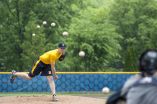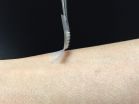Genetic study of 'co-evolution' could provide clues to better food production
Evolutionary 'arms race' between caterpillars and cabbage plants helped form present-day butterfly and plant species
2015-06-22
(Press-News.org) COLUMBIA, Mo. - In 1964, renowned biologists Peter Raven and Paul Erhlich published a landmark study that introduced the concept of co-evolution. Using butterflies and plants as primary examples, the team determined that two species can reciprocally drive each other's evolution and development. Now, an international team of researchers led by the University of Missouri and Stockholm University has used cutting-edge genomics to analyze the co-evolution theory and identified the mechanisms responsible for this phenomenon. Scientists believe that understanding how co-evolution works could help provide genetic clues for producing heartier plants and food for a growing global population.
The research team gained insight into the genetic basis of co-evolution between butterflies and cabbage plants was driven by new copies of genes rather than simple mutations on the strands of DNA of both species. This determination can provide new possibilities for creating more pest-resistant plants and potential food sources.
"Nearly 90 million years ago, the shared ancestor of broccoli, cabbage and papaya plants developed a chemical defense called glucosinolates," said Chris Pires, associate professor of biological sciences in the College of Arts and Science and a researcher in the Bond Life Sciences Center at MU. "Glucosinolates, or what humans enjoy as the sharp flavors of horseradish and mustard, which also are related to cabbage plants, is toxic to most insects. So, in this co-evolution 'arms race,' white cabbage butterflies and their relatives evolved the ability to detoxify glucosinolates soon after these chemical defenses appeared in plants. According to the research, this back-and-forth dynamic was repeated, resulting in the formationof more new species than in other groups of plants and butterflies without glucosinolates and the corresponding detoxification genes."
Using advanced genomics, scientists analyzed the evolutionary histories of plants and butterflies side-by-side, and discovered that major advances in the chemical defenses of the plants were followed by butterflies evolving counter-tactics that allowed them to keep eating these plants--thus genetically proving the co-evolution theories of Ehrlich and Raven more than 50 years ago.
"When we looked at the evolutionary histories of these plants and butterflies side-by-side, we discovered that major advances in the chemical defenses of the plants were followed by butterflies evolving counter-tactics that allowed them to keep eating these plants," said the other senior author Christopher Wheat, professor of population genetics in the Department of Zoology at Stockholm University. "This back and forth dynamic was found to be repeated over nearly 80 million years, resulting in the formation of more new species than in other groups of plants and butterflies without glucosinolate interactions. But perhaps the most important finding by the research team was waiting in the genomes."
This approach not only provides striking support for Ehrlich and Raven's hypotheses, but also provides fundamentally new insights into coevolutionary interactions between two groups of organisms, Pires said.
"If we can harness the power of genetics and determine what causes these copies of genes, we could produce plants that are more pest-resistant to insects that are co-evolving with them--it could open different avenues for creating plants and food that are more efficiently grown," Pires said.
INFORMATION:
The study, "The butterfly plant arms-race escalated by gene and genome duplications," was published in the Proceedings of the National Academy of Sciences (PNAS). Funding was provided by the National Science Foundation (PGRP 1202793), the Knut and Alice Wallenberg Foundation and the Academy of Finland. The content is solely the responsibility of the authors and does not necessarily represent the official views of the funding agencies.
Editor's Note: For more on the story, please see: http://decodingscience.missouri.edu/2015/06/22/scientists-uncover-how-caterpillars-created-condiments/
ELSE PRESS RELEASES FROM THIS DATE:
2015-06-22
Our brains track moving objects by applying one of the algorithms your phone's GPS uses, according to researchers at the University of Rochester. This same algorithm also explains why we are fooled by several motion-related optical illusions, including the sudden "break" of baseball's well known "curveball illusion."
The new open-access study published in PNAS shows that our brains apply an algorithm, known as a Kalman filter, when tracking an object's position. This algorithm helps the brain process less than perfect visual signals, such as when objects move to the ...
2015-06-22
Amid reports that rank today's teens as the most stressed generation in the country, a new study offers hope for helping them effectively manage stress and build long-term resiliency. A pilot study, published in the spring issue of the journal Advances in Mind-Body Medicine, describes how a stress-reduction/resiliency-building curriculum developed by the Benson-Henry Institute (BHI) at Massachusetts General Hospital (MGH) helped a group of Boston-area high school students significantly reduce their anxiety levels, increase productivity and effectively manage stress over ...
2015-06-22
PROVIDENCE, R.I. [Brown University] -- Fish are power eaters. In many species, large muscles running along their backs and bellies provide bursts of speed for chasing down prey. Then, at the very instant they close in, they vacuum victims into their suddenly gaping mouths with overwhelming suction. It turns out that these power surges are no anatomical coincidence. A new study shows that largemouth bass get their slurping power from the very same muscles that provide their swimming power.
In the Proceedings of the National Academy of Sciences, Brown University researchers ...
2015-06-22
Chemists and biologists at UC San Diego have succeeded in designing and synthesizing an artificial cell membrane capable of sustaining continual growth, just like a living cell.
Their achievement, detailed in a paper published in this week's issue of the Proceedings of the National Academy of Sciences, will allow scientists to more accurately replicate the behavior of living cell membranes, which until now have been modeled only by synthetic cell membranes without the ability to add new phospholipids.
'The membranes we created, though completely synthetic, mimic several ...
2015-06-22
WASHINGTON (June 18, 2015) -- Research published in the Proceedings of the National Academy of Sciences found that some individuals exposed to HIV-1, but who remain uninfected, have a certain pattern of virus-specific immune responses that differentiated them from individuals who became infected. The findings build upon prior research by studying these responses in the context of a controlled clinical trial, examining a large number of subjects, and by having access to specimens saved before anyone was infected. In the future, this information could be used to assess HIV-1 ...
2015-06-22
CHAPEL HILL, NC - Painful insulin injections could become a thing of the past for the millions of Americans who suffer from diabetes, thanks to a new invention from researchers at the University of North Carolina and NC State, who have created the first "smart insulin patch" that can detect increases in blood sugar levels and secrete doses of insulin into the bloodstream whenever needed.
The patch - a thin square no bigger than a penny - is covered with more than one hundred tiny needles, each about the size of an eyelash. These "microneedles" are packed with microscopic ...
2015-06-22
New Vanderbilt-led research shows hospitals are doing a better job of using antibiotics less commonly associated with antibiotic resistance to treat children hospitalized with community-acquired pneumonia (CAP).
The report, 'Antibiotic choice for children hospitalized with pneumonia and adherence to national guidelines,' was released today in the journal Pediatrics.
This study was nested within a larger study, the Centers for Disease Control and Prevention (CDC) Etiology of Pneumonia in the Community (EPIC). The multi-center EPIC study was a prospective, population-based ...
2015-06-22
DURHAM, N.C. -- Time management isn't just important for busy people -- it's critical for plants, too. A Duke University study shows how two biological clocks work together to help plants deal with intermittent demands such as fungal infections, while maintaining an already-packed daily schedule of activities like growth.
The researchers also identified a gene that senses disturbances in the 'tick-tock' of one clock, and causes the other clock to tighten its timetable. Their work appears in the June 22 issue of the journal Nature.
From daily sleep/wake cycles and fluctuations ...
2015-06-22
For diabetics, a quick prick of the finger can give information about their blood glucose levels, guiding them in whether to have a snack or inject a dose of insulin. Point-of-care glucose meters, or glucometers, are also used in the veterinary world to monitor cats and dogs with diabetes or pets hospitalized for other reasons. In both cases, the device's readout can literally be a matter of life and death.
While glucometers have the advantage of being fast and requiring only a small drop of blood, they are not as accurate as some other methods of measuring blood glucose. ...
2015-06-22
Mild elevations in blood pressure considered to be in the upper range of normal during young adulthood can lead to subclinical heart damage by middle age -- a condition that sets the stage for full-blown heart failure, according to findings of a federally funded study led by scientists at Johns Hopkins.
A report on the findings of the multicenter study that followed 2,500 men and women over a period of 25 years is published online June 22 in the Journal of the American College of Cardiology.
Persistently elevated blood pressure, or hypertension, is one that tops 140/90, ...
LAST 30 PRESS RELEASES:
[Press-News.org] Genetic study of 'co-evolution' could provide clues to better food production
Evolutionary 'arms race' between caterpillars and cabbage plants helped form present-day butterfly and plant species





